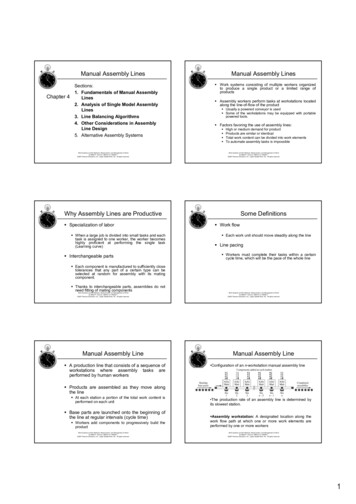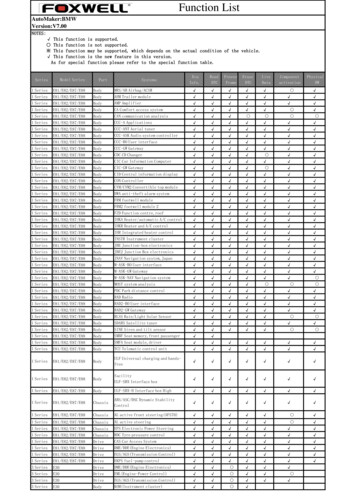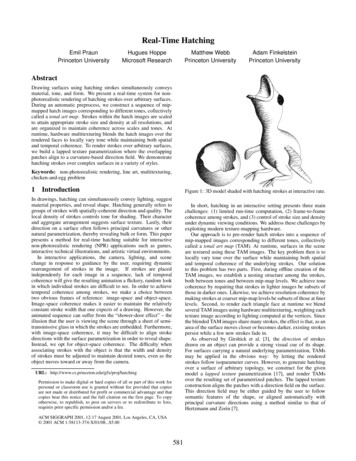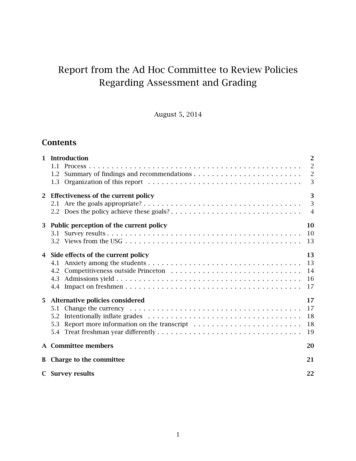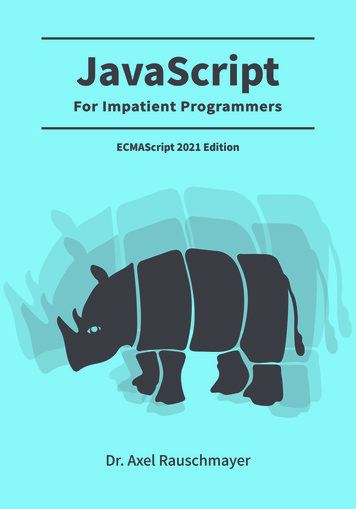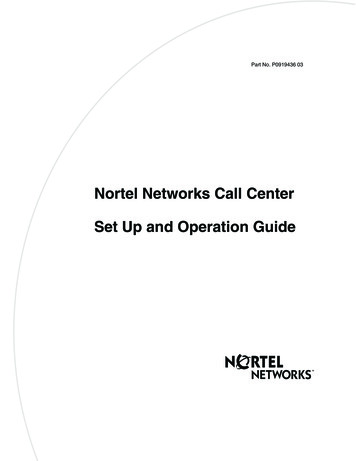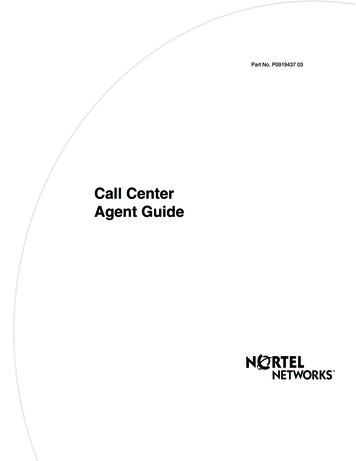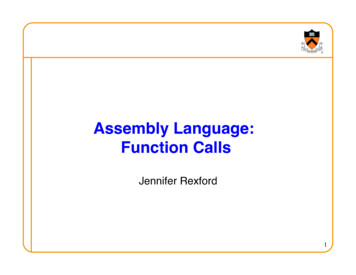
Transcription
Assembly Language:Function Calls"Jennifer Rexford!1
Goals of this Lecture" Function call problems:! Calling and returning!Passing parameters!Storing local variables!Handling registers without interference!Returning values! IA-32 solutions to those problems! Pertinent instructions and conventions!2
Recall from Last Lecture"Examples of Operands! Immediate Operand! movl 5, ! CPU uses 5 as source operand! movl i, ! CPU uses address denoted by i as source operand! Register Operand! movl %eax, ! CPU uses contents of EAX register as source operand!3
Recall from Last Lecture (cont.)" Memory Operand: Direct Addressing! movl i, ! CPU fetches source operand from memory at address i! Memory Operand: Indirect Addressing! movl (%eax), ! CPU considers contents of EAX to be an address! Fetches source operand from memory at that address! Memory Operand: Base Displacement Addressing! movl 8(%eax), ! CPU computes address as 8 [contents of EAX]! Fetches source operand from memory at that address!4
Recall from Last Lecture (cont.)" Memory Operand: Indexed Addressing! movl 8(%eax, %ecx), ! Computes address as 8 [contents of EAX] [contents of ECX]! Fetches source operand from memory at that address! Memory Operand: Scaled Indexed Addressing! movl 8(%eax, %ecx, 4), ! Computes address as 8 [contents of EAX] ([contents of ECX]* 4)! Fetches source operand from memory at that address! Same for destination operand, except ! Destination operand cannot be immediate!5
Function Call Problems"1. Calling and returning! How does caller function jump to callee function?!How does callee function jump back to the right place in callerfunction?!2. Passing parameters! How does caller function pass parameters to callee function?!3. Storing local variables! Where does callee function store its local variables?!4. Handling registers! How do caller and callee functions use same registers withoutinterference?!5. Returning a value! How does callee function send return value back to caller function?!6
Problem 1: Calling and Returning"How does caller function jump to callee function?! I.e., Jump to the address of the calleeʼs first instruction!How does the callee function jump back to the right place incaller function?! I.e., Jump to the instruction immediately following themost-recently-executed call instruction!7
Attempted Solution: Use Jmp Instruction" Attempted solution: caller and callee use jmp instruction!P:# Function P jmp RR:# Function R # Call Rjmp Rtn point1# ReturnRtn point1: 8
Attempted Solution: Use Jmp Instruction" Problem: callee may be called by multiple callers!P:# Function P jmp RR:# Function R # Call Rjmp ?# ReturnRtn point1: Q:# Function Q jmp R# Call RRtn point2: 9
Attempted Solution: Use Register" Attempted solution 2: Store return address in register!P:# Function PR:# Function Rmovl Rtn point1, %eax jmp Rjmp *%eax# Call R# ReturnRtn point1: Q:# Function Qmovl Rtn point2, %eaxjmp RRtn point2: # Call RSpecial form of jmpinstruction; we will not use10
Attempted Solution: Use Register" Problem: Cannot handle nested function calls!P:# Function PR:# Function Rmovl Rtn point1, %eax jmp Qjmp *%eax# Call Q# ReturnRtn point1: Q:# Function Qmovl Rtn point2, %eaxjmp R# Call RReturn address for P to Qcall is lostRtn point2: jmp %eaxProblem if P calls Q, and Qcalls R# Return11
IA-32 Solution: Use the Stack" May need to store many return addresses! The number of nested functions is not known in advance! A return address must be saved for as long as thefunction invocation continues, and discarded thereafter! Addresses used in reverse order ! E.g., function P calls Q, which then calls R! Then R returns to Q which then returns to P!EIP for QEIP for P Last-in-first-out data structure (stack)! Caller pushes return address on the stack! and callee pops return address off the stack! IA 32 solution: Use the stack via call and ret!12
IA-32 Call and Ret Instructions" Ret instruction “knows” the return address!P:# Function P call Rcall Q1!2!R:# Function R ret Q:# Function Q call R ret13
IA-32 Call and Ret Instructions" Ret instruction “knows” the return address!P:# Function PR:# Function R call Rretcall Q Q:3!4!5!# Function Q call R6! ret14
Implementation of Call" ESP (stack pointer register)points to top of stack!Instruction"Effective Operations"pushl srcsubl 4, %esp0movl src, (%esp)popl destmovl (%esp), destaddl 4, %espESP15
Implementation of Call" EIP (instruction pointerregister) points to nextinstruction to be executed!Instruction"Effective Operations"pushl srcsubl 4, %esp0Note: can’t really access EIPdirectly, but this is implicitlywhat call is doingmovl src, (%esp)popl destmovl (%esp), destaddl 4, %espcall addrpushl %eipjmp addrCall instruction pushes returnaddress (old EIP) onto stackESPbeforecall16
Implementation of Call"0Instruction"Effective Operations"pushl srcsubl 4, %espmovl src, (%esp)popl destmovl (%esp), destaddl 4, %espcall addrpushl %eipjmp addrESPaftercallOld EIP17
Implementation of Ret"0Instruction"Effective Operations"pushl srcsubl 4, %espmovl src, (%esp)popl destmovl (%esp), destNote: can’t really access EIPdirectly, but this is implicitlywhat ret is doing.addl 4, %espcall addrretpushl %eipjmp addrpop %eipRet instruction pops stack, thusplacing return address (old EIP)into EIPESPbeforeretOld EIP18
Implementation of Ret"0Instruction"Effective Operations"pushl srcsubl 4, %espmovl src, (%esp)popl destmovl (%esp), destaddl 4, %espcall addrpushl %eipjmp addrretpop %eipESPafterret19
Problem 2: Passing Parameters" Problem: How does caller function pass parameters tocallee function?!int add3(int a, int b, int c){int d;d a b c;return d;}int f(void){return add3(3, 4, 5);}20
Attempted Solution: Use Registers" Attempted solution: Pass parameters in registers!f:add3:movl 3, %eax movl 4, %ebx# Use EAX, EBX, ECXmovl 5, %ecx call add3ret 21
Attempted Solution: Use Registers" Problem: Cannot handle nested function calls!f:add3:movl 3, %eax movl 4, %ebxmovl 6, %eaxmovl 5, %ecxcall gcall add3# Use EAX, EBX, ECX # But EAX is corrupted! ret Also: How to pass parameters that are longer than 4 bytes?!22
IA-32 Solution: Use the Stack" Caller pushes parameters beforeexecuting the call instruction!0ESP beforepushingparams23
IA-32 Parameter Passing"0 Caller pushes parameters in thereverse order! Push Nth param first! Push 1st param last! So first param is at top ofthe stack at the time of the Call!ESPbeforecallParam 1Param Param N24
IA-32 Parameter Passing" Callee addresses params relative toESP: Param 1 as 4(%esp)!ESPaftercall0Old EIPParam 1Param Param N25
IA-32 Parameter Passing"0 After returning to the caller !ESPafterreturnParam 1Param Param N26
IA-32 Parameter Passing"0 the caller pops the parametersfrom the stack!ESPafterpoppingparams27
IA-32 Parameter Passing"For example:!f:add3: # Push parametersmovl 4(%esp), whereverpushl 5movl 8(%esp), whereverpushl 4movl 12(%esp), whereverpushl 3 call add3ret# Pop parametersaddl 12, %esp28
Base Pointer Register: EBP" Problem:! As callee executes, ESP maychange! E.g., preparing to callanother function! Error-prone for callee toreference params as offsetsrelative to ESP! Solution:!0ESPaftercall Use EBP as fixed referencepoint to access params!Old EIPParam 1Param Param NEBP29
Using EBP" Need to save old value of EBP!0 Before overwriting EBP register! Callee executes “prolog”!pushl %ebpmovl %esp, %ebpESPOld EBPOld EIPParam 1Param Param NEBP30
Base Pointer Register: EBP" Callee executes “prolog”!0pushl %ebpmovl %esp, %ebpESP,EBP Regardless of ESP, callee canreference param 1 as 8(%ebp),param 2 as 12(%ebp), etc.!Old EBPOld EIPParam 1Param Param N31
Base Pointer Register: EBP" Before returning, callee mustrestore ESP and EBP to theirold values!0ESP Callee executes “epilog”!movl %ebp, %esppopl %ebpretEBPOld EBPOld EIPParam 1Param Param N32
Base Pointer Register: EBP" Callee executes “epilog”!0movl %ebp, %esppopl %ebpretESP,EBPOld EBPOld EIPParam 1Param Param N33
Base Pointer Register: EBP" Callee executes “epilog”!0movl %ebp, %esppopl %ebpretESPOld EIPParam 1Param Param NEBP34
Base Pointer Register: EBP" Callee executes “epilog”!0movl %ebp, %esppopl %ebpretESPParam 1Param Param NEBP35
Problem 3: Storing Local Variables" Where does callee function store its local variables?!int add3(int a, int b, int c){int d;d a b c;return d;}int foo(void){return add3(3, 4, 5);}36
IA-32 Solution: Use the Stack" Local variables:! Short-lived, so donʼt need apermanent location inmemory! Size known in advance, sodonʼt need to allocate on theheap! So, the function just usesthe top of the stack! Store local variables on thetop of the stack! The local variables disappearafter the function returns!int add3(int a, int b, int c){int d;d a b c;return d;}int foo(void){return add3(3, 4, 5);}37
IA-32 Local Variables" Local variables of the calleeare allocated on the stack!0 Allocation done by moving thestack pointer!ESP Example: allocate memory fortwo integers!EBP subl 4, %esp! subl 4, %esp! (or equivalently, subl 8, %esp)!Var 2Var 1Old EBPOld EIPParam 1Param Param N Reference local variables asnegative offsets relative to EBP! -4(%ebp)! -8(%ebp)!38
IA-32 Local Variables"For example:!add3: # Allocate space for dsubl 4, %esp # Access dmovl whatever, -4(%ebp) ret39
Problem 4: Handling Registers" Problem: How do caller and callee functions usesame registers without interference?! Registers are a finite resource!! In principle: Each function should have its own set ofregisters! In reality: All functions must use the same small set ofregisters! Callee may use a register that the caller also isusing! When callee returns control to caller, old registercontents may be lost! Caller function cannot continue where it left off!40
IA-32 Solution: Define a Convention" IA-32 solution: save the registers on the stack! Someone must save old register contents ! Someone must later restore the register contents! Define a convention for who saves and restoreswhich registers!41
IA-32 Register Handling"0 Caller-save registers! EAX, EDX, ECXESP If necessary ! Caller saves on stack before call! Caller restores from stack after call! Callee-save registers!EBP EBX, ESI, EDI If necessary ! Callee saves on stack after prolog! Callee restores from stack beforeepilog! Caller can assume that values in EBX,ESI, EDI will not be changed by callee!Var 2Var 1Saved EBX,ESI,EDIOld EBPOld EIPParam 1Param Param NSaved EAX,EDX,ECX42
Problem 5: Return Values" Problem: How does calleefunction send return valueback to caller function?! In principle:! Store return value in stackframe of caller! Or, for efficiency:! Known small size storereturn value in register! Other store return value instack!int add3(int a, int b, int c){int d;d a b c;return d;}int foo(void){return add3(3, 4, 5);}43
IA-32 Return Values"IA-32 Convention:! Integral type or pointer:! Store return value in EAX! char, short, int, long, pointer! Floating-point type:! Store return value in floatingpoint register! (Beyond scope of course)! Structure:! Store return value on stack! (Beyond scope of course)!int add3(int a, int b, int c){int d;d a b c;return d;}int foo(void){return add3(3, 4, 5);}44
Stack Frames"Summary of IA-32 function handling:! Stack has one stack frame per active function invocation! ESP points to top (low memory) of current stack frame! EBP points to bottom (high memory) of current stackframe! Stack frame contains:! Return address (Old EIP)! Old EBP! Saved register values! Local variables! Parameters to be passed to callee function!45
A Simple Example"int add3(int a, int b, int c){int d;d a b c;return d;}/* In some calling function */ x add3(3, 4, 5); 46
Trace of a Simple Example 1"x add3(3, 4, 5);Low memoryESPEBPHigh memory47
Trace of a Simple Example 2"x add3(3, 4, 5);Low memory# Save caller-save registers if necessarypushl %eaxpushl %ecxpushl %edxESPOld EDXOld ECXOld EAXEBPHigh memory48
Trace of a Simple Example 3"x add3(3, 4, 5);# Save caller-save registers if necessarypushl %eaxpushl %ecxpushl %edx# Push parameterspushl 5pushl 4pushl 3Low memoryESP345Old EDXOld ECXOld EAXEBPHigh memory49
Trace of a Simple Example 4"x add3(3, 4, 5);# Save caller-save registers if necessarypushl %eaxpushl %ecxpushl %edx# Push parameterspushl 5pushl 4pushl 3# Call add3call add3Low memoryESPOld EIP345Old EDXOld ECXOld EAXEBPHigh memory50
Trace of a Simple Example 5"int add3(int a, int b, int c) {int d;d a b c;return d;}# Save old EBPpushl %ebpLow memoryESPPrologOld EBPOld EIP345Old EDXOld ECXOld EAXEBPHigh memory51
Trace of a Simple Example 6"int add3(int a, int b, int c) {int d;d a b c;return d;}# Save old EBPpushl %ebp# Change EBPmovl %esp, %ebpPrologLow memoryESPEBPHigh memoryOld EBPOld EIP345Old EDXOld ECXOld EAX52
Trace of a Simple Example 7"int add3(int a, int b, int c) {int d;d a b c;return d;}Low memoryESP# Save old EBPpushl %ebp# Change EBPmovl %esp, %ebp# Save caller-save registers if necessarypushl %ebxUnnecessary here; add3 will notpushl %esichange the values in these registerspushl %ediEBPHigh memoryOldOldOldOldOldEDIESIEBXEBPEIP345Old EDXOld ECXOld EAX53
Trace of a Simple Example 8"int add3(int a, int b, int c) {int d;d a b c;return d;}# Save old EBPpushl %ebp# Change EBPmovl %esp, %ebp# Save caller-save registers if necessarypushl %ebxpushl %esipushl %edi# Allocate space for local variablesubl 4, %espLow memoryESPEBPOldOldOldOldOldEDIESIEBXEBPEIP345Old EDXOld ECXOld EAXHigh memory54
Trace of a Simple Example 9"int add3(int a, int b, int c) {int d;d a b c;return d;}Low memoryESPEBP# Save old EBPpushl %ebp# Change EBPmovl %esp, %ebp# Save caller-save registers if necessarypushl %ebxpushl %esipushl %edi# Allocate space for local variablesubl 4, %espAccess params as positive# Perform the additionoffsets relative to EBPmovl 8(%ebp), %eaxaddl 12(%ebp), %eaxAccess local vars as negativeaddl 16(%ebp), %eaxoffsets relative to EBPmovl %eax, -16(%ebp)High memory12Old EDIOld ESIOld EBXOld EBPOld EIP345Old EDXOld ECXOld EAX55
Trace of a Simple Example 10"int add3(int a, int b, int c) {int d;d a b c;return d;}# Copy the return value to EAXmovl -16(%ebp), %eax# Restore callee-save registers if necessarymovl -12(%ebp), %edimovl -8(%ebp), %esimovl -4(%ebp), %ebxLow memoryESPEBPHigh memory12Old EDIOld ESIOld EBXOld EBPOld EIP345Old EDXOld ECXOld EAX56
Trace of a Simple Example 11"int add3(int a, int b, int c) {int d;d a b c;return d;}# Copy the return value to EAXmovl -16(%ebp), %eax# Restore callee-save registers if necessarymovl -12(%ebp), %edimovl -8(%ebp), %esimovl -4(%ebp), %ebx# Restore ESPmovl %ebp, %espLow memoryESPEBPEpilogHigh memory12Old EDIOld ESIOld EBXOld EBPOld EIP345Old EDXOld ECXOld EAX57
Trace of a Simple Example 12"int add3(int a, int b, int c) {int d;d a b c;return d;}# Copy the return value to EAXmovl -16(%ebp), %eax# Restore callee-save registers if necessarymovl -12(%ebp), %edimovl -8(%ebp), %esimovl -4(%ebp), %ebx# Restore ESPmovl %ebp, %espEpilog# Restore EBPpopl %ebpLow memoryESP12Old EDIOld ESIOld EBXOld EBPOld EIP345Old EDXOld ECXOld EAXEBPHigh memory58
Trace of a Simple Example 13"int add3(int a, int b, int c) {int d;d a b c;return d;}# Copy the return value to EAXmovl -16(%ebp), %eax# Restore callee-save registers if necessarymovl -12(%ebp), %edimovl -8(%ebp), %esimovl -4(%ebp), %ebx# Restore ESPmovl %ebp, %esp# Restore EBPpopl %ebp# Return to calling functionretLow memoryESP12Old EDIOld ESIOld EBXOld EBPOld EIP345Old EDXOld ECXOld EAXEBPHigh memory59
Trace of a Simple Example 14"x add3(3, 4, 5);# Save caller-save registers if necessarypushl %eaxpushl %ecxpushl %edx# Push parameterspushl 5pushl 4pushl 3# Call add3call add3# Pop parametersaddl 12, %espLow memoryESP12Old EDIOld ESIOld EBXOld EBPOld EIP345Old EDXOld ECXOld EAXEBPHigh memory60
Trace of a Simple Example 15"x add3(3, 4, 5);# Save caller-save registers if necessarypushl %eaxpushl %ecxpushl %edx# Push parameterspushl 5pushl 4pushl 3# Call add3call add3# Pop parametersaddl %12, %esp# Save return valuemovl %eax, whereverLow memoryESP12Old EDIOld ESIOld EBXOld EBPOld EIP345Old EDXOld ECXOld EAXEBPHigh memory61
Trace of a Simple Example 16"x add3(3, 4, 5);# Save caller-save registers if necessarypushl %eaxpushl %ecxpushl %edx# Push parameterspushl 5pushl 4pushl 3# Call add3call add3# Pop parametersaddl %12, %esp# Save return valuemovl %eax, wherever# Restore caller-save registers if necessarypopl %edxpopl %ecxpopl %eaxLow memory12Old EDIOld ESIOld EBXOld EBPOld EIP345Old EDXOld ECXOld EAXESPEBPHigh memory62
Trace of a Simple Example 17"x add3(3, 4, 5);# Save caller-save registers if necessarypushl %eaxpushl %ecxpushl %edx# Push parameterspushl 5pushl 4pushl 3# Call add3call add3# Pop parametersaddl %12, %esp# Save return valuemovl %eax, wherever# Restore caller-save registers if necessarypopl %edxpopl %ecxpopl %eax# Proceed! Low memoryESPEBPHigh memory63
Summary" Calling and returning! Call instruction: push EIP onto stack and jump! Ret instruction: pop stack to EIP! Passing parameters! Caller pushes onto stack! Callee accesses as positive offsets from EBP! Caller pops from stack!64
Summary (cont.)" Storing local variables! Callee pushes on stack! Callee accesses as negative offsets from EBP! Callee pops from stack! Handling registers! Caller saves and restores EAX, ECX, EDX if necessary! Callee saves and restores EBX, ESI, EDI if necessary! Returning values! Callee returns data of integral types and pointers in EAX!65
6 Function Call Problems" 1. Calling and returning! How does caller function jump to callee function?! H

